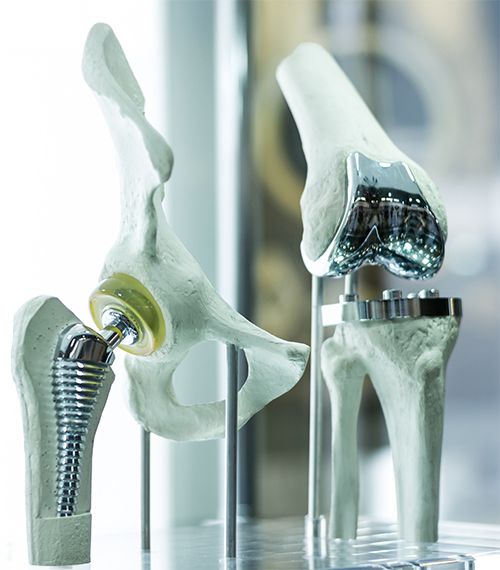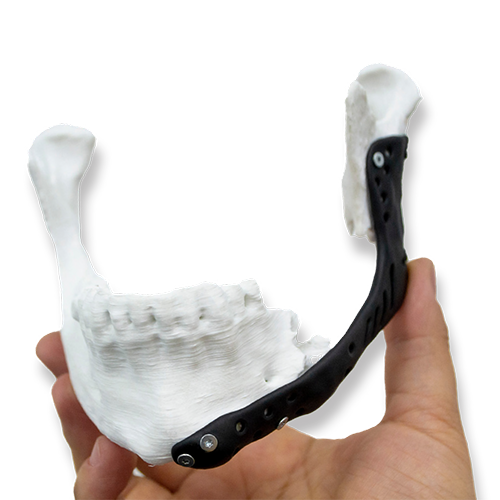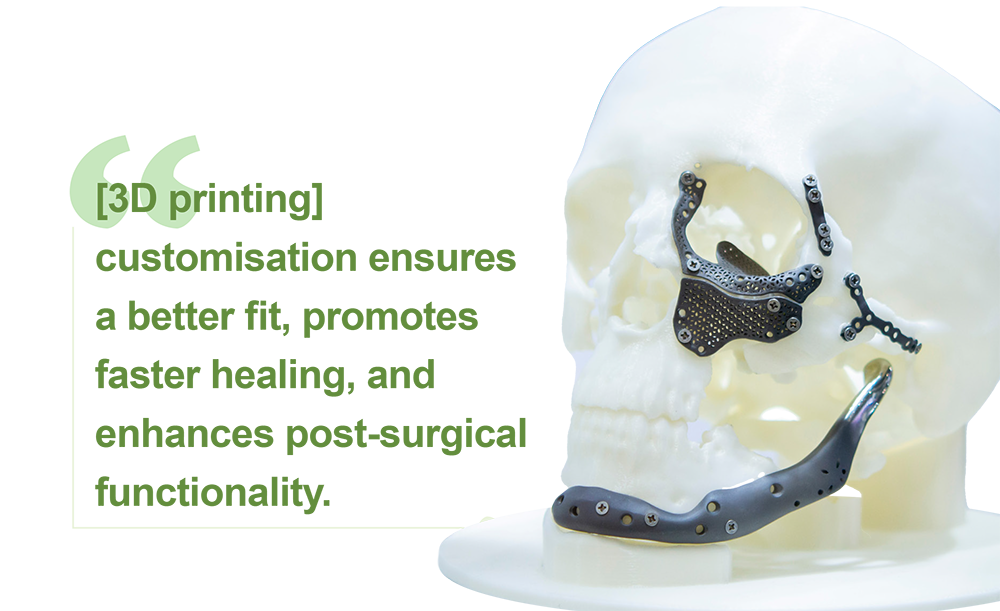3D PRINTING FOR IMPLANTS IN HOSPITALS
3D printing technology is now an integral part of modern medical care, especially in hospitals. Many medical institutions have set up dedicated 3D laboratories to explore its diverse applications. One of its most impactful uses is in surgery, where it enables virtual planning and digital preparation of procedures. A key application is the creation of sawing jigs, which enhance the precision and efficiency of bone cutting—an essential step in preparing joint prostheses and implants. Additionally, 3D printing is increasingly being used to manufacture custom implants for a wide range of medical needs.
Application of 3D Printing Technology in Surgery
The most common application of 3D printing in operating theatres is the production of saw guides. These guides can significantly shorten the duration of complex oncological surgeries— sometimes by as much as 25%. By streamlining bone defect reconstruction, they contribute to better surgical outcomes. Additionally, 3D-printed moulds enable the creation of implants during surgery using bone cement, further supporting bone defect repair.
Use of 3D Printed Implants
Although still relatively uncommon, 3D-printed implants are becoming more widespread. Notable examples include skull implants for reconstruction after trauma or tumor removal, as well as jaw and spinal implants. In some cases, 3D printing is also used to create plates secured with screws to stabilize fractures. In rare instances, even joint prostheses are produced using this technology.

Materials for 3D Printed Implants
A variety of materials are used for 3D-printed implants, with titanium and PEEK (polyetheretherketone) being the most common. Both are biocompatible, meaning they are well-tolerated by the body, reducing the risk of rejection. Additionally, these materials promote osteointegration, allowing bone tissue to grow into the implant and form a strong bond with the surrounding bone.
Other materials include zirconia, which is primarily used for dental crowns and, occasionally, joint prostheses. Bioresorbable polymers are also used to print temporary medical devices, such as screws and pins that naturally dissolve in the body after the bone heals.
Benefits of 3D Printing for Implants
A significant advantage of 3D printing in implant production is its ability to create highly precise, personalised implants tailored to individual patients. This customisation ensures a better fit, promotes faster healing, and enhances post-surgical functionality. Additionally, 3D printing often shortens the production time for patient-specific implants compared to traditional manufacturing methods. In many cases, it is also more cost-effective to print a custom implant rather than modify an entire production process to create a single patient-specific piece.
Regulations and Challenges in Clinical Practice
For 3D-printed implants to be used in clinical practice, they must comply with strict regulatory and quality standards. As a result, clinical studies are often required before an implant can be approved for patient use. Currently, large-scale production of 3D-printed implants in hospitals in the Netherlands remains unfeasible due to the complexity, high costs, and stringent quality requirements.
While advancements in 3D printing have accelerated implant production, a significant gap remains between the availability of custom-printed implants and the convenience of off-the-shelf alternatives. Moreover, custom-made 3D implants remain more expensive than mass-produced ones, limiting their widespread adoption.

Complexity of Bone Defects and the Role of 3D Printing
In cases involving complex anatomical structures, determining the exact size and shape of a bone defect before surgery can be difficult. This uncertainty makes it challenging to 3D-print an implant in advance, as the precise specifications often become clear only during the operation.
Future Developments: Bioprinting
A promising advancement in 3D printing is bioprinting, a technique that uses living cells to create implants for clinical applications. These cells, often derived from patient stem cells, can be transformed into specialized bone cells that seamlessly integrate with the body.
While bioprinting is still in its early stages, it holds great potential for developing fully biocompatible implants that naturally merge with human tissue. Currently, ceramic implants are already being 3D-printed to gradually fuse with the body’s bone tissue, marking an important step toward future biological implants.
Conclusion
The use of 3D printing technology in bone repair represents a groundbreaking advancement in healthcare. Its precision, customisation, and efficiency provide significant benefits for both patients and medical professionals. While challenges such as cost and regulatory approval remain, ongoing innovations continue to expand the potential applications of 3D printing. In the near future, 3D-printed implants are expected to become a standard component of medical treatment, improving patients’ quality of life worldwide.
